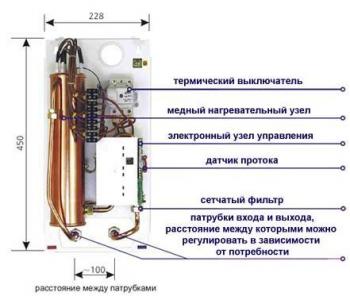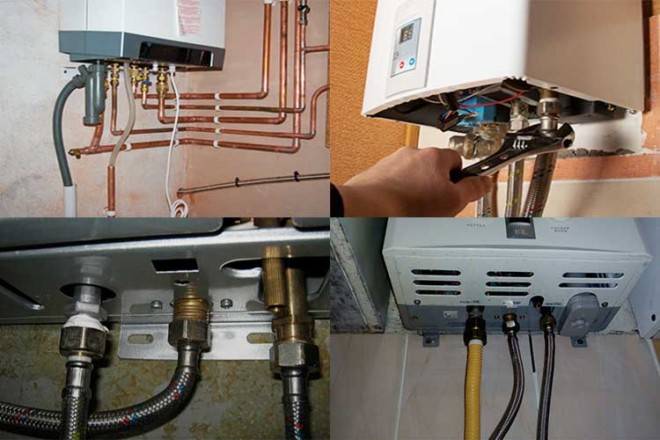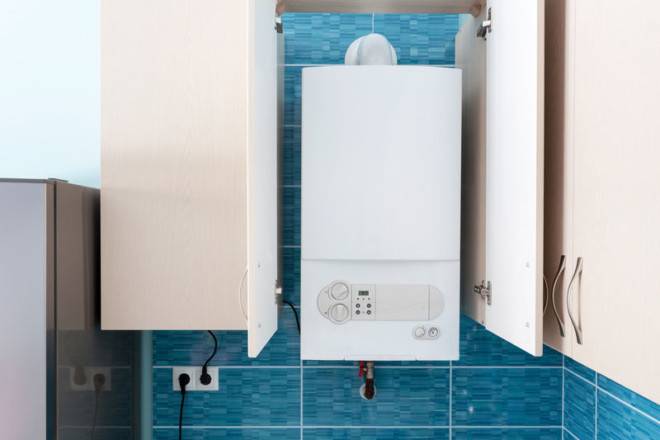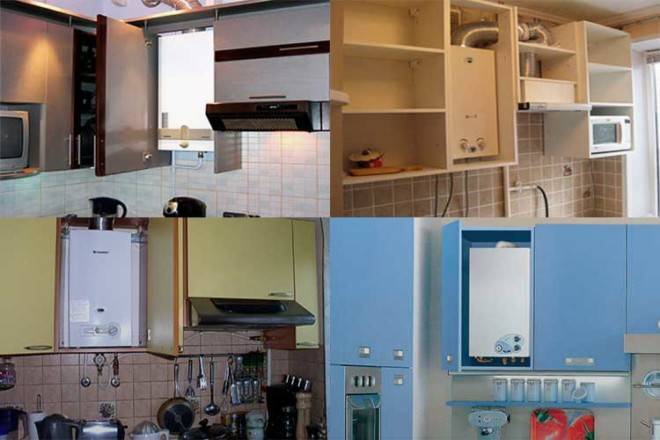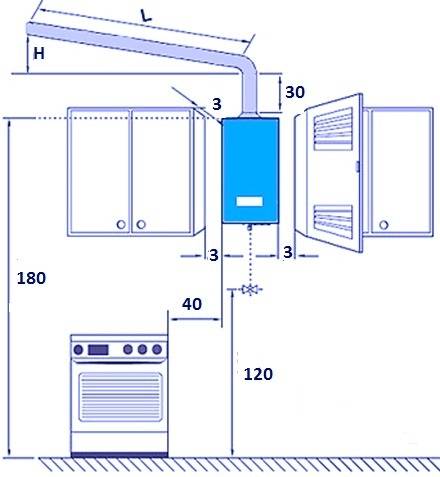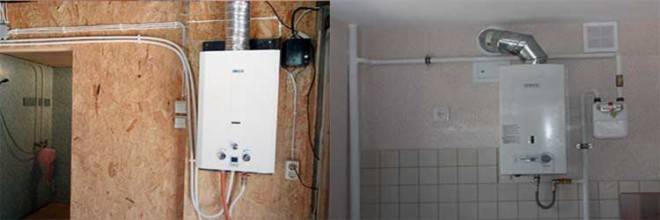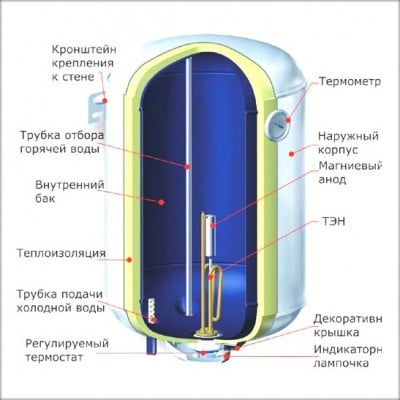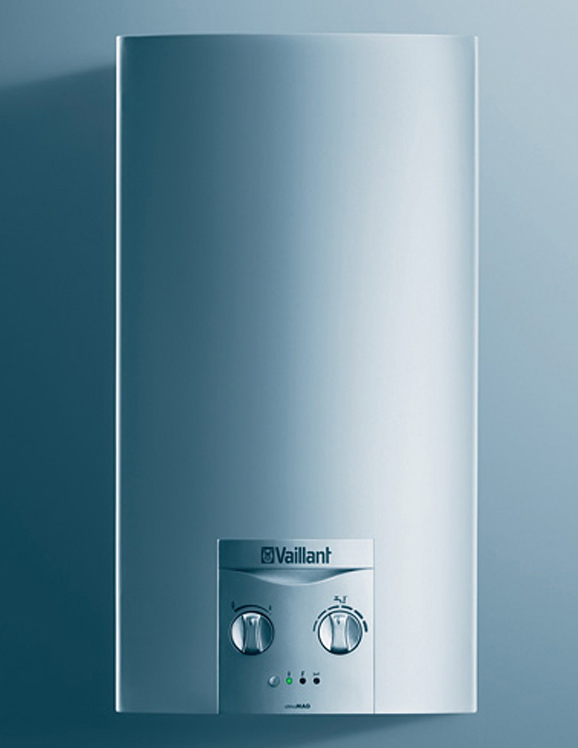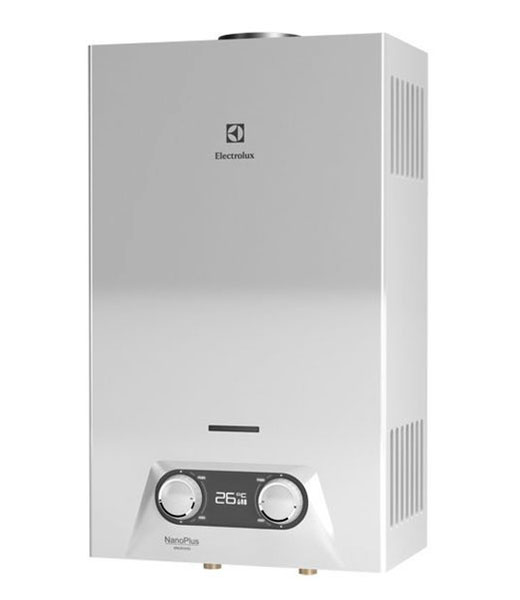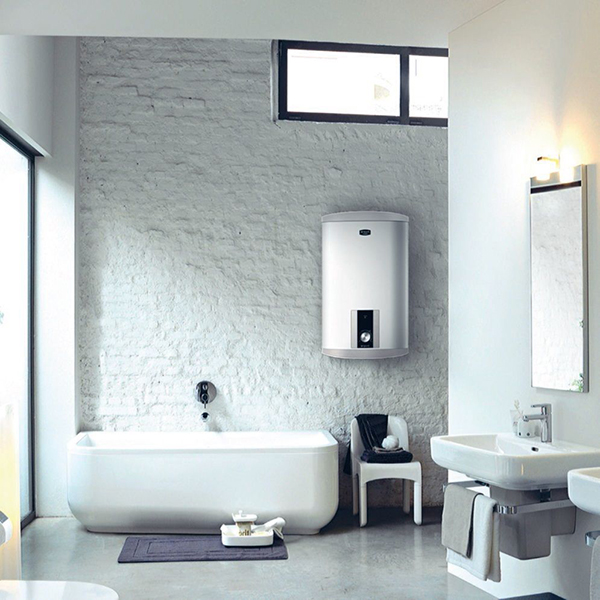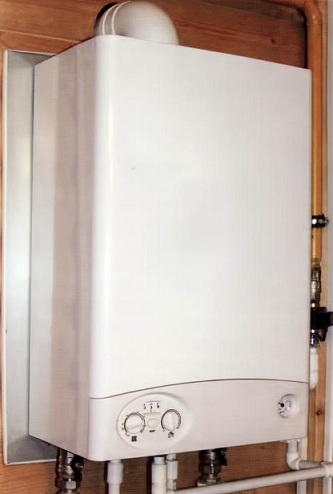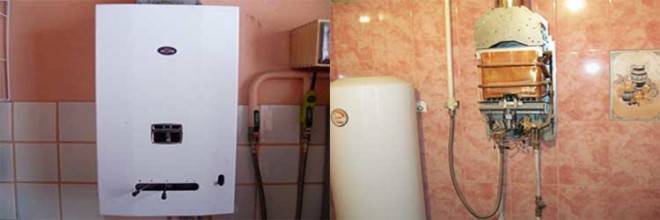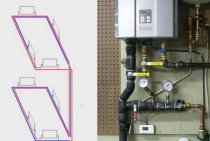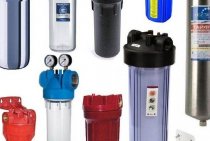Electric instantaneous water heater
Instantaneous water heaters work according to the following principle: passing through the heating element, water immediately flows from the hot tap (up to 60ºС). Such devices are compact, easy to install and reinstall, if necessary, to a new location. Their big minus is high power - from 3 to 24 kW. For this reason, they can only be used in places where the electrical network is provided for such a high power. In houses with conventional electrical wiring, where there are gas stoves, the maximum allowable load on the electrical network is 3 kW.
Therefore, choosing such a device, you will have to change not only the wiring, but also the meter, the introductory machine, and install another additional machine directly for the water heater. All these costs can exceed the cost of the water heater itself. In houses equipped with electric stoves, the maximum load on the network is 8 kW. In this case, an instantaneous water heater can be connected to the wiring for the stove, but these devices can only be used in turn. The main advantage of instantaneous water heaters is that they are able to produce hot water in unlimited quantities, but the disadvantage is the impossibility of simultaneously providing several points with hot water.
Starting and configuring the geyser
Before starting the column, it is necessary to check all the seams of the connection with the water supply and gas pipeline hoses. They must be sealed. There is a proven method by which you can check the tightness of gas connections.
How to check the tightness of gas connections:
- Lubricate all joints and fittings of the gas pipe with soapy water;
- Open the gas valve;
- Check connections for bubbles.
If there are no bubbles, then the connections are tight. Checking the connections to the water supply can be done without special accessories, just making sure that the joints are dry.
Next, you need to perform all the necessary steps to start the column according to the instructions. The setting is a very important step. It can only be done with a pressure gauge. The adjusting bolt sets the gas pressure, and the air supply with the shim.
Advantages and disadvantages of storage water heaters
The use of a boiler can be a solution to the acute problem of lack of hot water in buildings without a gas pipeline. These can be non-gasified areas of the private sector or suburban real estate, where there is running water and access to electricity. Other obvious advantages of this electrical equipment:
- no documents need to be collected, because the installation of an electric boiler does not require special permits;
- you can install it even on your own, having the necessary knowledge and experience;
- plastic pipes are sufficient for mounting the device;
- lack of strict installation requirements, because the device works without open flame;
- the force of water pressure does not affect its temperature regime, as is the case in some models of gas water heaters;
- the equipment has the correct shape and modern design, which allows you to optimize the space;
- the stores offer a variety of models of boilers, equipped with convenient options, the size and color scheme of which can be chosen for any type of interior.
Features of self-assembly
In the case of a simple replacement of the unit, its installation can be carried out without the involvement of specialists, since communication connections are already available and all that remains is to change the equipment.
When carrying out installation operations, the following points must be taken into account:
- first, you should outline the attachment points of the column on the wall, for which it is first necessary to remove its landing dimensions;
- the hanging place should be chosen so that the distance to the nearest outlet is at least 0.5 meters (with a room height of up to 2.75 meters);
- with a higher room height, this removal may be slightly less (up to 0.25 meters).
For safety reasons, the height of the geyser on the wall should not allow small children to reach the control panel
It is very important to accurately measure the distance between the mounting holes, which allows you to hang the speaker on hooks or special brackets without any difficulty. Taking into account all the factors listed above, mounting the column comes down to simply hanging it at the desired height.
How to install a geyser
We have come directly to the stage of installation of the geyser. If you have gas lines installed, all the necessary documentation has been received and all specifications have been met, then it will not be difficult to install it yourself.
How to install the column correctly:
- The front panel is removed from the column. According to the marking of the column mounts, mark the places for the installation of anchors. The correctness of the markup is checked using the building level. Now, according to the markup, you need to drill holes, insert dowels and anchors.
- Most modern speakers have a special fixing plate. It must be installed at the marked level, leveling with a building level.
- Install the column itself on the plate. Clicks indicate the correct installation.
- Lay a corrugated pipe from the outlet of the column to the common chimney. Treat the wall with a perforator and insert the chimney. The gap between the wall and the chimney must be filled with foam.
It's too early to install the front panel yet. First you need to connect to gas and water.
We prepare documents before connecting the geyser
The first installation of a geyser requires a lot of fuss with documentation and rather high costs. However, this fact does not scare most apartment owners.
To install a column in an apartment where gas supply is not provided, you will have to conduct these lines yourself. Alone, such work will cost you quite a lot, so it is better to team up with neighbors who, like you, want to install a column.
The first installation of a column includes the following "Paper" steps:
- You need to obtain consent to supply gas from distributors and conveyors and install a land allotment for the gas pipeline. You also need to make a calculation of consumption and get a list of technical conditions.
- Next, you need to design. This stage consists of concluding an agreement, collecting and examining documents, as well as obtaining permission in several instances.
- After the installation works, an agreement is concluded in GORGAZ and OBLGAZ.
To obtain all the necessary permits, you need to collect a whole list of documents. We will give you the most complete list, however, depending on the area in which you live and how many times you install a column, the list may decrease.
List of documentation required to obtain a permit:
- A copy of the document confirming that you are the owner of the apartment;
- Copy of pages 2, 3 and 5 of your passport;
- A copy of your TIN;
- Permission to process your data;
- Document on the purchase of gas, as well as a letter indicating the conclusion of a work contract;
Gas equipment maintenance contract;
TU for connection to gas and documents on the implementation of TU;
Copies of gas equipment;
A copy of the act on the division of property between the owner of the apartment and the distributor;
Copies of technical passports of the gas meter and confirmation of their verification;
A copy of the draft gasification project and the stamp of the metrological department of Gazprom.
The prepared list of documents is referred to the appropriate authorities. After some time, you should receive a verdict from the gas services.
Where can I install
According to the rules for installing gas water heaters in apartments, they are allowed to be installed in kitchens with sufficiently high ceilings and if there is a chimney opening with a diameter of at least 120 millimeters. It is also assumed that in these rooms there is a permanent ventilation that provides safe conditions for the operation of gas equipment.
The characteristics of modern models of gas water heaters make it possible to operate them at high humidity, that is, in the bathroom, without a traditional chimney.
Necessary changes in the project involve the laying of pipe outlets with access to the street, which ensures the flow of air into the closed chamber and the removal of combustion products from it.
The following strict requirements are imposed on the premises in which it is supposed to operate gas equipment:
- the height of the room must exceed 2 meters;
- the volume of the room can be at least 8 cubic meters;
- it must have natural ventilation (at least one window), as well as a channel for arranging a chimney.
The showers available in the rooms are not suitable for these purposes and therefore are immediately excluded from consideration.
We add to this that the carrier pressure in the water line cannot be lower than 0.1 atmosphere, and the wall intended for hanging the unit must be made of non-combustible materials. In addition, it is not allowed to install it close to the gas stove (technical standards allow the unit to be mounted at a distance of at least 10 centimeters from it).
Electric storage water heater
In a storage water heater (boiler), water is heated to 35-38ºС and then its temperature is maintained at this level automatically. When the tap is opened, warm water flows out of the tank, and the next portion of cold water enters the tank instead. The duration of water heating in these water heaters depends on two parameters. This is the volume of the tank and the power of the heating element. In order to minimize energy losses, water tanks are made insulating (in the form of a thermos), which does not allow the heat of water to be transferred to heat the room where the water heater is installed.
Typical device of a storage electric water heater
Such a device can be connected to a conventional outlet, since high power is not required for the gradual heating of water. For example, 150-liter water heaters of this type consume no more than 2 kilowatts. It is this circumstance that makes these devices popular, since they can be installed in almost any room. In addition, the high demand for them is due to another advantage of storage water heaters: water can be consumed from two water intake points at the same time - both in the kitchen and in the bathroom.
On the other hand, boilers have some disadvantages. These are large dimensions, the need for periodic maintenance: cleaning the heating elements from scale, replacing the magnesium anode. It is no secret that any heating element becomes covered with scale during operation, which reduces its heat transfer, and, consequently, the consumption of electricity for heating water increases. To protect the heating element from scale, a magnesium anode in the form of a rod is built in near it. Dissolving during operation, it reduces the formation of scale. As wear and tear, and this depends on the intensity of operation and the level of water hardness, the anode is changed. The volume of heated water depends on the capacity of the tank, so when choosing a storage water heater, you need to focus on the capacity you need.
A tank that is too large will consume more electricity, and it will take up extra space. Therefore, you should think carefully in order to choose a device with the optimal capacity for you, not to spend extra money and not take up extra space.If the water heater is needed only to supply warm water in case of periodic shutdowns, a volume of 10-15 liters will be sufficient. Only for taking a shower, a device with a tank capacity of 50 liters will suffice. For a hot bath, a tank with a volume of up to 150 liters is required. In a country house where there is no centralized hot water supply, the required volume is 200 liters or more.
Most manufacturers produce horizontal and vertical models, and modern universal designs have recently been created (installed as needed - either horizontally or vertically).
Unit selection guidelines
1. Which appliance suits you best: electric or gas.
2. Having calculated how much hot water you need, select the volume of the storage water heater or the flow capacity.
3. Decide on the installation location of the device for heating water: on the wall, above the sink or under it and select the desired model.
2016-12-30
Sergey Dyachenko
To figure out which is better - a boiler or a gas water heater, consider the pros and cons of both devices.
Advantages of the boiler:
- Ease of installation. For the installation of a storage water heater, it is not required to collect any documents and permits. No need for good ventilation and chimney.
- The ability to provide warm water to several points of water intake at once.
- Independence from the pressure in the water supply. Where the geyser does not turn on due to low pressure, the boiler will work properly.
- Noiselessness. For heating, a tubular electric heater is used, which does not make any sounds.
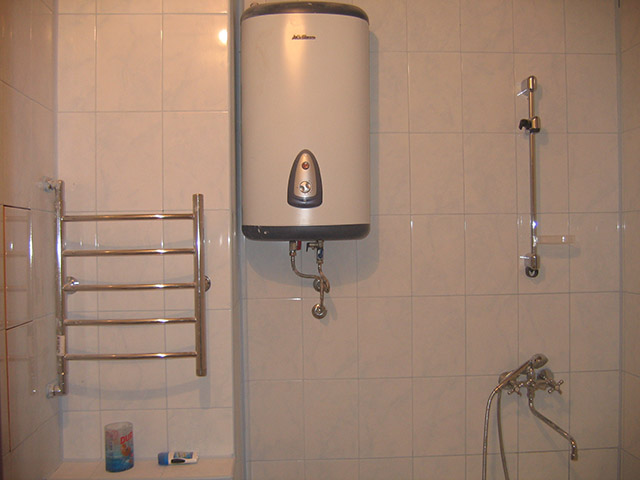
Disadvantages of storage water heaters:
- Long reheat time compared to columns. If the hot water in the tank runs out, you will have to wait from 30 minutes for the next portion to heat up (the reasons why hot water does not flow are described).
- Limited amount of water. If you choose the wrong volume, then there may not be enough water to meet the FGP needs of all residents.
- Dependence on electricity. If you turn off the light in the room, then the water will gradually cool down.
- Large dimensions. This can be a problem in small apartments with small bathrooms, where every square meter counts.

Scale accumulation. From time to time, the boiler requires cleaning from salt deposits. If you do not regularly perform preventive maintenance, then over time the water heats up more and more time.
In turn, geysers have the following advantages:
- Instant heating. When you open the tap in just a few seconds, the consumer receives hot water.
- Unlimited water. If there is water in the apartment, then the column can work constantly. The amount of water is not limited by the size of the tank.
- Small dimensions. New models are compact and do not take up much space in the kitchen.
- Independence from electricity. If the house turns off the light, the column will continue to work.
Disadvantages of gas water heaters:
- The need to collect additional documents during installation. Before you install a geyser, you must coordinate the project with utilities and obtain permission.
- The need for a quality chimney. For the operation of a gas water heater, it is necessary that the products of combustion go outside. This requires a chimney, the state of which will have to be monitored all the time.
If it clogs, then at best the protection will work and the flame will go out. If for some reason it does not work, there is a danger of carbon monoxide poisoning.
- Pressure dependency. If there is a weak pressure in the water supply system, the gas will not open and the column will not work. Modern models with the ability to adjust the pressure inside the device partially solve this problem.
Also, if two points of water intake are connected and water is turned on in the second one, the temperature in the first one will drop. This is not very convenient when the temperature of the water changes during the shower.
Impossibility of placement in the bathroom. Due to safety standards, gas flow heaters are not allowed to be installed in bathrooms.
To decide what to choose, it is important to consider the installation location. If you live in a private house that is heated by a boiler, it is advisable to purchase an indirect heating boiler, which will be the most profitable.
Part of the heat that goes to heating will go to heating tap water. It is advisable to purchase a combined model that has an additional heating element in order to provide hot water in the summer.
In an apartment where there is no gas meter and 1-2 people are registered, you need to install a gas water heater, which will be cheaper than a boiler due to a fixed payment for gas. An additional argument will be the small size of the apartment; a compact gas flow heater is better suited for Khrushchev.
If you have a nightly rate for electricity, get a boiler with a large tank capacity, because it will be most economical to turn it on at night and then use heated water during the day. Thermal insulation is installed between the body and the tank, due to which the cooling occurs very slowly.
Scheme of connecting a geyser to water and gas
If you are installing a column for the first time, then you will have to run a gas pipe to it. To do this, you will need to invite craftsmen who will cut the tee in the gas pipe and mount the pipe on it.
You can sling the pipe directly to the connection point. This gas connection scheme eliminates the need for a gas hose. In this case, you must first install the column, and only then connect the gas pipe.
Another option is more practical, as it allows you to install a column at any time convenient for you. In this case, the pipe is led to the installation for only half a meter, and the remaining route is installed by installing a gas valve.
Next, you need to connect the gas pipe to the water supply. This connection is best done with a movable union nut.
Ball valves are installed on the lines of cold and hot water. It is also desirable to install coarse and fine filters before the column. Such devices will allow you to increase the life of the heat exchanger.
To connect water to the column, you can run a pipe for 30 cm and finish the rest of the distance with a flexible hose or connect pipes made of steel, metal-plastic or propylene directly to the column. To install pipes, you will need to mount a special tee in the water supply.
Advantages and disadvantages of modern geysers
The main advantage of these devices is the ability to instantly heat a large amount of water. And this function does not depend on the size of the devices. This is ideal for a large family that consumes large amounts of water every day.
Also, gas units of this sample compare favorably with their electric "brothers":
- compact size - which allows you to use them even in small rooms;
- unlimited volumes of heated water;
- high heating rate (about 17 liters per minute);
- economy;
- rare preventive maintenance (during the year it is enough to check the pressure level only once, and if the power of the device and the temperature of water heating decrease, flush the heat exchanger);
- long service life.
However, there are some difficulties:
- before installing this water heater, it is necessary to submit a package of documents to the appropriate authorities to obtain permission to install a geyser;
- after receiving an official document authorizing the installation of this equipment, it is required to invite specialists to:
- summing up the gas pipeline;
- checking and adjusting the ventilation system;
- direct installation of the device.
- strict requirements for installing the device imply the purchase and installation of metal pipes (the column can get very hot, and such high temperatures are unacceptable when using plastic products);
- the wall on which the device will be mounted must be treated with a sufficient amount of a substance that ensures its resistance to high temperatures (often a rather thick layer is required);
- according to safety requirements, the water-heating gas unit must be placed in the kitchen (where the ventilation system is established and there is a chimney). To minimize the burning of oxygen in the room, it should be ventilated (and done regularly).
Naturally, if the gas pipeline is not provided in the building, the use of such equipment is impossible. The only acceptable option in such conditions is an electric boiler, the advantages and disadvantages of which we will now consider.
Advantages and disadvantages of electric boilers
Electric boilers are still more versatile. Their advantages include:
- The heater is able to work in homes where there is no gas supply system.
- There is no need to buy expensive metal pipes and install a ventilation system.
- Safety in use.
- The device can install by yourself
, while the gas appliance can only be installed by specialists. - The pressure of hot water does not depend on the number of taps open in the house.
The disadvantages of these devices are due to their design:
- an electric water heater is less economical in terms of energy consumption;
-
large dimensions
; - shorter service life compared to gas heaters.
Of course, both the column and the electric water heater have their advantages and disadvantages. Therefore, it is quite difficult to unambiguously answer the question of what to choose, a boiler or a gas water heater. When choosing, it is worth, first of all, starting from the presence of gas in the house and the economic factor.
Nevertheless, any device is able to fully eliminate such a problem as the lack of hot water in the house.
Unstable hot water supply is a common problem. However, you can successfully protect yourself from the inconvenience that this unpleasant phenomenon causes by installing a gas or electric water heater. A variety of types and models of such equipment on the market allows you to choose the best option for a particular home. But which is better: a boiler or a gas water heater - an objective answer can be obtained by comparing the features of these types of water heaters.
Modern geysers are very different from the unaesthetic bulky appliances of yesteryear. Now these are devices with an attractive design and compact dimensions that easily fit into any interior. There are two types of geysers, differing in the type of ignition:
- automatic columns - their work begins from the moment the water tap is opened;
- semi-automatic - to start such equipment, you need to light the wick manually.
Rules for installing a geyser
As you probably understand, in order to install any gas appliance, you must comply with the relevant rules and regulations. If you neglect at least one of them, you risk not only getting into trouble with the law, but also causing the death of people close to you.
If you already have an old speaker, then you can easily replace it with a new device yourself. However, do-it-yourself installation of the device from “a” to “z” is prohibited.
If you decide to connect a gas water heater yourself, or entrust only part of the work to special services, then you need to familiarize yourself with the basic rules of SNiP for such installation. They are applicable both in the apartment and in a private house.
SNiP standards:
- Installation of a gas type column is possible only in a room with a volume of at least 7 cubic meters. meters;
- The wall you plan to hang your speaker on should be made of a non-combustible material such as brick or concrete.
- In the room where the gas water heater will be installed, there must be a window and a good ventilation system;
- In an apartment with a column, the ceilings must have a height of at least 2 meters;
- In order to install a column, you need to find a chimney in the room;
- For normal operation of the column, the water pressure in the system must be at least 1 atm.
- You can not install a column in the bathroom and toilet, and the gas unit must be at least 10 cm from the stove. At the same time, a column cannot be hung above the stove.
These are the new norms of SNiP regarding the installation of a geyser. The old norms were somewhat different, so if your old column is installed in the bathroom, you can put a new unit in its place, and this will not be a violation of the law.
Advantages and disadvantages of gas water heaters
If we talk about which device to choose, first of all it should be noted: for a gas heater, you must have gas supply systems
in a house or apartment. That is why devices are rarely installed in summer cottages.
The advantages of the unit include the following factors:
-
Profitability.
If buyers are interested in the question of what is more profitable, a column or a boiler, it is worth choosing the gas option. - The gas appliance is quite compact.
- The main advantage of the column is the ability to instantly provide hot water in any volume.
- Speakers last much longer than eclectic devices, they are easy to operate.
There are also disadvantages:
-
Difficulty of installation
. This requires not only to call specialists and purchase metal pipes, but also to collect the necessary package of documents. Ventilation system required. - When using a column, the presence of open fire is not expected. Before attaching the equipment to the wall, it should be treated with a thick layer of insulating material.
- When using a heater, open water taps in the house affect the pressure in the tap.
Norms and requirements
Measures for the transfer or installation of a gas unit are conventionally divided into two categories:
- installation work carried out in a room (building) where gas-powered equipment was not previously used;
- the procedure for connecting a gas column, accompanied by the replacement of the old unit with a new model.
In the first case, before starting work, it will be necessary to prepare project documentation, which lays down the requirements for arranging branches from gas and water mains. After the project is ready and agreed with all interested organizations, it will be possible to apply to the local department of housing and communal services to connect an already purchased device.
The main requirements for the installation of such equipment are regulated by the following regulations:
- Code of Practice No. 42-101 of 2003, establishing the procedure for preparing a project for connecting gas distribution systems.
- Code of Practice No. 42-01 of 2002 concerning the clarification of the concept of "gas distribution system".
The main provisions of these documents relate to the technical characteristics of the equipped premises, as well as the features of the location of the dispenser itself. The water heaters installed in the bathrooms, in accordance with the current technical standards, do not have to be transferred to another place when they are replaced.
This rule does not apply to the case when the user himself insists on moving the column at his own expense.
Choosing a modern geyser
A geyser is a universal solution to the problem of supplying a dwelling with hot water.This is a really convenient and practical device that does not require saving electricity due to low power consumption. The important point was that the use of columns was not always safe. But much was compensated by convenience - just unscrew the valve, and hot water was supplied to the bathroom and kitchen. Heating was carried out by igniting the column with ordinary matches. The danger was pressure drops, the column also became clogged, the water could boil over and break through the pipes. Bulky and inconvenient, the old devices did not allow them to be installed unnoticed and without the participation of a team of craftsmen.
Modern speakers are much safer and more convenient in their design. In the first place is the external design of the system - such devices easily and conveniently fit into the interior or are masked. These are highly functional and ergonomic security systems. Ignition is carried out through a piezoelectric element, without the risk of fire.
